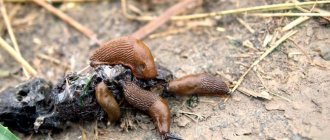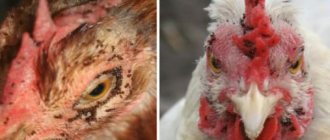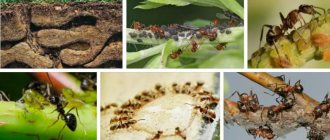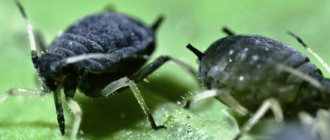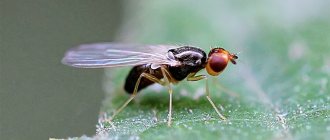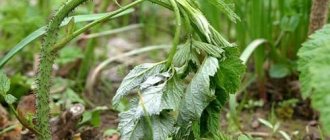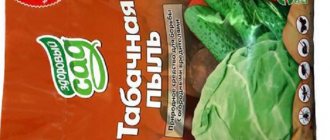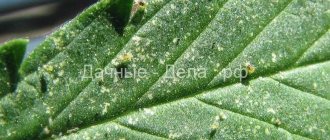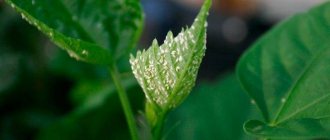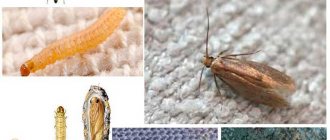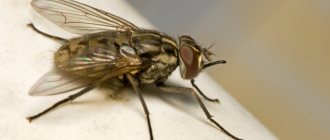| Pictured is a slug, slug |
Slug or slug is the common name for some gastropods, or, more simply, snails. Slugs differ from snails by the absence of a shell. Like snails, slugs are found primarily in damp places. Slugs can eat a wide variety of foods. Slugs also have a lot of enemies, and due to their weak defenses, slugs themselves often become food for various predators.
| Pictured is a slug |
Description of the slug. The slug's body has an elongated shape and can easily change its shape due to muscle contraction. Their slug bodies secrete a large amount of mucus. This secreted mucus helps improve the body's gliding when moving, which greatly facilitates the movement of the slug. Mucus also helps maintain moisture in the slug's body and prevents it from drying out. To some extent, the mucus also serves to scare away predators, since the slug has no other defense abilities, but has a lot of enemies. Slugs move slowly and are very vulnerable. There are tentacles on the slug's head, one or two pairs of which contain the slug's eyes and sensory organs. Slugs can live for several years.
About slugs. Slugs are a widespread pest of many crops, vegetables, fruits and berries. Some types of slugs can cause significant damage to crops, sometimes completely destroying the entire crop. Slug infestations can occur in rainy years. Slugs serve as reservoirs and carriers for many parasites and various worms. Slugs reproduce quickly; several generations of slugs can grow in a season.
Who eats slugs? Although slugs have many enemies, among them there are none that feed mainly on slugs. Many birds, jackdaws, crows, rooks, starlings, and some species of gulls feed on slugs. Slugs and poultry, chickens and ducks, are also eaten. Snakes, lizards, salamanders, toads and frogs like to hunt slugs. Some mammals, such as moles, shrews, hedgehogs and mouse-like rodents, also readily eat slugs. Some types of insects can also eat slugs.
Slugs as pests. Slugs live in a variety of places, including the ability to live comfortably in dachas and vegetable gardens. From such a neighborhood, summer residents may experience a significant reduction in harvest. Slugs love almost everything: fruits, vegetables, berries, salads. Not only do slugs destroy crops, but they also spread many infections, all kinds of parasites, and spread fungal and viral diseases. All these diseases have a detrimental effect on the health of plants, animals and people. All this taken together can reduce all the efforts of the summer resident to zero. Therefore, slugs need to be dealt with, preventing them from reproducing. And slugs reproduce very quickly, especially in rainy and humid weather.
| How to deal with slugs? |
Measures to combat slugs. How to deal with slugs? Slugs love moisture and damp places, but slugs do not like heat. If possible, you should regularly drain places where water and moisture accumulate on the site. It is necessary to collect slugs in a timely and regular manner, preventing them from breeding and multiplying, and slugs reproduce very quickly. In order to collect more slugs on the site as simply and quickly as possible, you can make special artificial baits and slug traps for this on the site. To create such baits, you need to lay out the rinds of watermelons, melons, pumpkins on the garden bed, or you can simply use pieces of cellophane or jars of liquid in which slugs will collect. Early in the morning you will need to assemble these slug traps and destroy any slugs caught in them. Poultry, chickens and ducks can eat slugs, but you probably shouldn't feed them slugs, because slugs are the source and carriers of various diseases. To catch slugs, you can make shelters in the area from small boards, cellophane, or pieces of roofing felt. Under these shelters, slugs will regularly gather to safely wait out the heat of the day, which slugs cannot tolerate. Slug control should be carried out regularly.
Below on the website you can view and download large and beautiful photos of slugs.
Photos of slugs and slugs:
Slugs are gastropods. They live on land. These animals do not have a shell. But, despite the lack of protection, slugs cause a lot of damage in the garden. Therefore, it is simply necessary to fight them.
Meet the enemy
Slugs belong to the group of mollusks; more than 250 species of these creatures are found in our country. Slugs love to eat - they like lettuce, cabbage, strawberries, raspberries, currants, carrots, asters, petunias, zinnias, dahlias, lilies, nasturtiums. They gnaw on the shoots of young plants, eat holes in roots and leaves, and damage fruit, vegetable, ornamental and other plants.
It's impossible to get rid of pests forever, but there are ways to control or reduce their numbers, keep them away from well-kept flower beds, and reduce losses. It is the naked slugs (without shells) that cause the damage. Their brothers with a house on their back are mostly harmless.
The main culprits of losses:
- Limacidae - from the pulmonary family.
- The Spanish slug (Arion lusitanicus) is a mollusk of the pulmonate family. Can grow up to 15 cm, gray-green, sometimes yellow-brown. Omnivorous, reproduces very quickly, is considered an invasive species, a pest.
- The netted slug (Deroceras reticulatum) is a mollusk from the family Agriolimacidae. It grows up to 6 cm, is gray-yellow or dark red in color, and leaves behind a thick whitish mucus.
Attention! Slugs are omnivores, they even feed on feces, so they can carry dangerous viruses and bacteria - you should not touch them with your bare hands, it is better to collect pests using rubber gloves.
Mollusks feed in the evenings, at night and in the morning, when dew appears. During the day they hide in cool, shady corners of the garden:
- under stones;
- in thick grass;
- under a pile of boards;
- near the composter;
- in decomposing plant debris.
If there are a lot of mollusks, they can cause great damage to flower beds and beds. Naked snails (without shells) are omnivores and cause the most damage to the garden. They can eat whole plants, often feeding in the lower parts, on young plants, and eat irregular holes in leaves, leaving sticky mucus behind. Slugs destroy the roots of root crop plants - carrots, parsley, beets.
However, slugs are important from an ecological point of view. Most shellfish feed on dead and rotting matter, including:
- dead, rotting plants;
- fallen leaves;
- mushrooms;
- falling fruits;
- animal droppings;
- carrion.
If clams are eating lettuce, the leaf may already be damaged or diseased. The great slug (Limax maximus) is a voracious predator that feeds on slugs (including those that eat lettuce) and other pests.
Ultimately, if it were not for slugs and similar organisms, recycling of organic material would be more difficult, and nutrients needed by ecosystems would remain encapsulated in the cell walls of dead plants and animals. Slugs and snails themselves are also a valuable food source for:
- insects,
- toads,
- snake,
- Zhukov,
- birds.
Therefore, dealing with snails is not so easy. This is a fight against windmills, warn gardeners and farmers.
How to prevent damage to valuable plants? There are many tips on how to get rid of slugs on cabbage, strawberries, in greenhouses and basements - some are myths, others are more effective. Using chemicals is an effective solution. However, while these drugs limit the number of slugs, they also kill other beneficial animals such as earthworms and pose a threat to the environment.
All kinds of baits, elaborate traps, loosening the soil - none of these things solve the problem 100%. The ideal solution is to create an ecosystem in the garden that will provide balance in nature.
Types of slugs
There are many different types of gastropods. There are those that are widespread, and there are species that are found in a certain area.
Large slug
The size varies from 100 to 200 mm. The shade is yellowish, ashen or dirty white. White sole, dark pink tentacles. It is a pest of greenery and often lives in vegetable stores. In turn, there are representatives of this subspecies: black, spotted, red.
Field slug
A particularly harmful representative that reproduces in high humidity. Damages vegetables, ornamental crops, and greens. Tolerates late blight and downy mildew. There are more than 100 species representatives in total.
Road slug
Mollusk with a hard shield on one third of the body. It is nocturnal and afraid of the bright sun. It reproduces quickly and adapts to changing conditions. Can withstand moisture levels up to 50%.
Proper soil preparation and planting
It is important to maintain order in the area:
- After the first frost, the beds need to be loosened to reveal wintering shellfish and eggs. Without shelter, they will not survive harsh winter conditions.
- It is advisable to use mulching. An organic layer of straw, sawdust, and crushed tree bark protects the soil from drying out and accelerates its heating.
But you cannot use fresh plant waste or mowed grass for mulching.
- Young seedlings and seedlings are especially vulnerable to being eaten. Moreover, they germinate when the mollusks are hungry. Plants should only be sown when the soil is warm enough. The faster the plants grow, the less damage the slugs will cause.
- It is important to remove weeds thoroughly. They provide pests with protection from desiccation and an additional source of food. You should regularly weed the beds and remove plant debris.
- Lawns should be mowed on time, natural meadows should be mowed, tall grass is an ideal hiding place for shellfish.
- Compost is an ideal environment (and food source) for these pests.
How they appear in a vegetable garden or garden plot
On your land, you need to look for slugs under large leaves, in thickets of grass, and heaps of compost. In addition, mollusks live in damp cellars, basements and cellars.
In natural conditions of the wild, land gastropods maintain by their existence the ecological equality of forest and field communities. When we transfer an infected plant from a forest, field, or steppe to our site, we ourselves provoke the reproduction of the slug in our possessions. After all, the pest very readily accepts cultivated plantings as a food source (more than 150 plants) and begins to actively reproduce in a new place.
Constantly watering the beds and flowers and maintaining moisture makes his stay even more comfortable. And favorable weather conditions (humid and warm springs, autumns and summers, mild winters) contribute to the massive takeover of human-cultivated territories by slugs.
Proper watering
Mollusks love moisture. Dry weather makes them less active. Many animals remain in the soil, preventing themselves from drying out. Only occasionally do they crawl to the surface to satisfy their hunger. Due to lack of water, they become weaker and die from dehydration.
Important watering rules:
- Flower beds should not be watered in the evening.
- The soil between the rows should remain dry so that water flows only to the plants.
- The surface of flower beds and lawns sprayed with water is a bait for pests.
- If necessary, watering should begin early in the morning.
Natural enemies
Almost everything in nature is included in food chains. Slugs are no exception; there are several species of animals that eat these mollusks:
- insects;
- frogs, toads;
- lizards;
- wild birds - blackbirds, robins, starlings, rooks, pheasants, jays, gulls;
- poultry;
- hedgehogs;
- moles;
- shrews.
Birds
Blackbirds are the most famous lovers of slugs, but these slimy creatures are also liked by robins, crows, and starlings. Some poultry (chickens, ducks) can help reduce slug numbers.
Ducks of the Indian Runner breed, according to reviews from summer residents, effectively cope with regulating the number of slugs in the garden.
Chickens and ducks, Indian runner ducks eat some types of snails and slugs. The problem is that in search of food they can eat our crops - lettuce, young plants. You can let poultry get rid of snails in the garden in early spring, before sowing or planting seedlings.
Jerzy
Hedgehogs also love shellfish, so it's worth inviting them into the garden. There are many opportunities to invite a hedgehog to live in your garden. It’s worth thinking about building a house for him:
- from the few bricks left over from the construction of the house;
- from stones intended for rock gardens;
- a wooden box lined from the inside with hay, leaves, or other heat-insulating material.
Hedgehogs will use such shelter. During the warmer months, the animals will rest in the house during the day; during the cold months, they will spend the rest of the year in the house to safely hibernate and survive until next spring.
Nematodes
Nematode roundworms make up more than 80% of the total number of multicellular animals on Earth. Nematodes are almost everywhere - in water and on land. To date, about 20,000 different species have been identified.
Some nematodes live as parasites of gastropods. The species is called the parasitic slug nematode (Hermaphrodita Phasmarhabditis). It is used to control slugs in organic farming. These beneficial animals live in the ground and enter the body of the pest through the mantle cavity. There, nematodes release bacteria, which causes the slug to stop eating. Nematodes multiply in the body of the mollusk, causing it to swell. Within 7-10 days the pest dies. Preparations based on nematodes are considered environmentally friendly.
Characteristics of representatives
Large roadside is the most common species in the garden. It is large in size. Sometimes it is called leopard print. Its color is gray-spotted.
The blue slug is often called the Carpathian slug. This is due to the fact that it is found only in the region of these mountains. It is large in size and brightly colored. Prefers coniferous and deciduous forests of Ukraine, Poland, Slovakia and the Czech Republic. Its diet includes russula, which is what gives the giant blue slug its amazing color. The accumulation of this species will be a tip to the mushroom picker. This means that there is a mushroom clearing nearby somewhere.
The naked slug is the most famous species in Russia. This annoying pest not only lives in the garden, but also loves greenhouses and greenhouses. Leaves large holes on fruits and leaves.
The black type of mollusk is the largest. Some individuals are up to 30 centimeters long. Mushrooms are what slugs of this species eat. He also loves root vegetables.
Another large representative is the banana slug. It is not found in banana plantations and will not look like a banana, but is a bright yellow color. It feeds on lichen, mushrooms and rotten leaves.
Small species include the field slug. Its dimensions do not exceed 5−6 centimeters. It lives in valleys and on the edges of forests. Young shoots and wild berries make up its diet. Comes in all shades of brown.
In moss thickets you can find whole groups of reticulated slugs. This species loves loose soil and rotten leaves. He is one of the smallest representatives. Its dimensions do not exceed 3 centimeters. Very often has a spotted color.
Repellent plants
Another way is to plant plants in the garden that repel slugs:
- marjoram,
- garden savory,
- garlic,
- onion,
- sage,
- coriander,
- medicinal hyssop,
- yarrow,
- periwinkle,
- sagebrush,
- mustard,
- common thyme.
However, according to the experience of many gardeners, slugs safely overcome beds with tasteless garlic and get to tasty zucchini and lettuce. Therefore, it is debatable whether plants that snails dislike will be effective in keeping them away from our garden.
Features of reproduction
By their nature, slugs are hermaphrodites - each individual simultaneously has both female and male sexual characteristics. However, laying eggs requires cross-fertilization, so individuals search for each other by smell.
After mating, they exchange sperm with each other, and after some time they lay 20-25 eggs in moist soil. Literally 2-3 weeks later, new slugs appear and live by feeding on the remains of organic matter. After 1.5-2 months they grow and begin to reproduce.
Adults that lay eggs in the fall die. The duration of the development cycle may vary and depends on weather conditions. In some cases, pests that did not have time to lay eggs in the fall overwinter in the ground, and after the onset of spring they begin laying eggs.
Attractive plants
On the other hand, there are plants that slugs like more than vegetables. If grown in the garden, they will attract snails, which can be taken outside the garden area.
Real delicacies for slugs are:
- chamomile,
- marigold,
- asters,
- zinnia,
- dahlias,
- hosts,
- lilies,
- nasturtiums,
- rudbeckia.
Snails often feed on raspberries, strawberries, strawberries, and they like beets, cabbage, carrots and lettuce. You need to collect ripe fruits that lie on the ground under the trees (apricots, peaches, pears, apples).
Chamomile is a favorite delicacy for slugs. You can rub the plant well; the smell of chamomile attracts these pests.
Slugs also love marigolds and vetch. You can pick a handful of vetch and place it in the garden bed; the next day it will be full of shellfish. Snails like picked plants and love compost. It is easy to collect shellfish from such places.
We remove shellfish from the site
Gardeners try different methods, most of which often end tragically for slugs in the garden, which play an important role in the decomposition and circulation of organic matter in nature, helping to fertilize the soil. How to get rid of slugs in a summer cottage in a humane way?
It turns out that it is enough to take them out. Instead of killing snails, it is better to move them 20 meters or more out of your own garden, according to researchers from the School of Physics and Astronomy at Queen Mary University of London.
“A recent Royal Horticultural Society study found that one in five UK gardeners throw shellfish into their neighbor’s garden. This may be a better solution than killing them, but we believe it should benefit the entire community, so they should be sent to empty land rather than abandoned to neighbors,” said study co-author Prof. David Dunstan.
How to deal with slugs?
There are several methods that experienced gardeners and gardeners recommend using.
To expel or destroy slugs, it is recommended to use:
- manual collection of pests;
- spices;
- baited traps;
- spraying;
- dry mulch;
- protective barriers;
- frogs;
- hedgehogs
It is very important to start the fight against uninvited guests in time, otherwise they can multiply on the site so much that it will be quite difficult to get rid of their invasion.
Traps
A cheap, effective and humane method is to catch the snails and move them to another location. However, direct fishing is labor intensive. Manual snail disposal only helps when it is done consistently and systematically. The ideal collection time is in the evening after warm rain and early in the morning. The following are used as bait for snails:
- wheat bran,
- kitchen waste,
- beer,
- citrus peel.
The best results are achieved when placing one pile of bait per 0.5 square meters.
Various types of traps can be used:
- Jar – You can drown slugs by placing them in a jar completely filled with water, finally screwing the lid on tightly. A bucket of water will not work; the shellfish will simply crawl out of it.
- Beer traps: Beer fermentation products attract slugs. Any cheap beer will work as bait. The open container is buried in the ground so that the edge is at ground level, and beer is poured. Slugs, attracted by the smell of beer, become trapped and drown in the drink.
- Grapefruit halves – After eating grapefruit, place empty fruit halves near plants that attract slugs. The clams hide in the fruit halves and are easy to collect in the morning.
- Boards laid in a moist, shady place, above a dug hole, effectively attract these voracious mollusks. Such a pit maintains humidity, pests take refuge there. They can then be easily collected from there. We put bait under the boards:
- cabbage leaves,
- leftover potatoes, carrots,
- bran.
- Snails love cardboard, especially corrugated cardboard, as a place of refuge. The cardboard is placed in a shaded place and watered. Some slugs will hide in the folds of cardboard. It is important to collect them carefully.
Attention! Sometimes beer traps can do more harm than good. Shellfish love beer, but this attractive lure makes crowds of drink lovers crawl towards it even from outside the garden.
Manual collection
If there are only a few shellfish, you can try to collect them by hand and then destroy them - for example, in a concentrated saline solution or vinegar. The most effective method is to collect by hand late in the evening at dusk or early in the morning (when slugs are active) and destroy the slugs using a shovel or some other sharp object or by placing them in a 10% solution of table salt for one day.
The Spanish slug uses dead or wounded fellow species as food. Therefore, dead slugs can be left to attract other individuals in a certain place, but in this case this place must be re-examined. If slugs are destroyed before July, they should be buried in the ground. If slugs are destroyed in August or September, in order to prevent their eggs from entering the environment and the further spread of this species, dead slugs must be burned or placed in a solution of table salt.
Mechanical limiters
Copper, copper barriers
Slugs don't like to crawl on copper. Will come in handy:
- a dozen copper coins placed in the soil around the seedlings can create a border;
- electrical cable without insulation;
- support sticks, the rods used to support the plant, can be wrapped in copper wire, making sure that no leaves touch the ground and no weeds touch the plant.
Copper hoops and copper tapes create a barrier through which snails cannot pass. They hate copper. It should be remembered that slugs undermine the ground, so the hoops must be inserted quite deeply. The method is quite expensive.
Eggshell
The sharp edges of eggshells repel shellfish, but only when they are clean, dry. When peeling an egg, try to remove the inner membrane. In addition, as egg shells break down, they fertilize acidic soil.
Coffee
Unlike us, slugs don't like the smell of ground coffee. Sprinkling coffee around plants that are often attacked by shellfish can help repel them. You can mix coffee with eggshells. Coffee grounds also decompose, enriching the soil with minerals and acidifying it. Lack of coffee - the method works until the first rain.
Ash
To get rid of slugs on cabbage, gardeners in the morning when there is dew or immediately after watering the plants, dust it with ash so that the ash covers the leaves and sticks to them. Ash can also be scattered around cabbage and other plants. Slugs don't like her very much.
Plastic bottles
In the first phase of plant growth, it is worth covering them with large plastic bottles, preferably 5 liter ones. This method will limit slugs' access to newly planted or seeded plants. This bottle is placed on the plant until it becomes large, when the risk of snails eating it in one night is lower. The bottle must be inserted quite deeply because the mollusks sit in the ground and can penetrate from below. This works well early in the season. It is advisable to cover the neck with gauze to prevent pests from sneaking in.
Bentonite
Bentonite is a natural rock, a natural clay mineral, which has the ability to strongly absorb water and swell. That's why it is used to make cat litter. Bentonite can be a natural garden fertilizer and soil structure improver. Bentonite clay has many properties, including protection against insects and diseases, and can also be used as a garden salve.
Bentonite nourishes the earth, it is a source of about 70 microelements - calcium, magnesium, potassium, silica, aluminum, iron. The powder is used to stabilize soil moisture, reducing the need for watering during drought. Expansion and contraction by absorbing and releasing water also improves soil structure. Well-saturated bentonite maintains constant soil moisture for up to 2 weeks. It also works as a slug barrier around garden beds.
Lime
Powdered or granulated lime is used as a barrier, sprinkled around plants and flower beds. Upon contact with lime, the slug dies. It is necessary to consider how much lime can affect the soil pH; on alkaline soils the method can be harmful. The method must be repeated after rain.
Installation of fences and barriers
An effective remedy is barriers, plastic or tin, 30 cm high, the top edge is curved outward, so the mollusks cannot cross it.
The fence should be installed in early spring and regularly checked for leaks. Instead of fencing the entire surface of the flowerbed, individual plants can be protected with special rings.
Straw, sawdust, ash
It is useful to create barrier strips on roads to vegetable beds. Slugs are reluctant to move on dry soil. Scattering dry sawdust, ash, and straw along migration routes effectively prevents their movement.
Attention! Sawdust and husks lose their effect after rain; the protective layer must be replaced.
What should not be used!
- Salt. Slugs sprinkled with salt become dehydrated and die. The disadvantage of this method is that you have to find the pests first. Sprinkling salt around plants will stop snails, but many plants don't like salty conditions and will die. High soil salinity will not be beneficial.
- Shells, shells. The sharp edges of the shells stop the snail, but do not break like egg shells, and can be a serious inconvenience when weeding flower beds for many years.
Chemicals
Many gardeners use chemicals to control slugs without realizing the danger to other animals. Granular chemical preparations for slugs will remove them forever or for a long time, but they also poison predators that feed on mollusks (hedgehogs, birds). They can pose a threat to pets and other animals if used in excess. The blue or green pellets have a sweet taste and are attractive to dogs and sometimes cats. Animals willingly lick the pellets, which ends tragically. The toxic substance used in granular slug preparations, metaldehyde, attacks the central nervous system, causing painful death.
When using chemicals, you must strictly follow the instructions on the packaging. The chemicals work until the first rain, then they must be reapplied.
Insecticides used against slugs:
- “Groza” is a molluscicide of contact-intestinal action;
- “Slug eater” – based on metaldehyde;
- "Predator";
- "Stopulit";
- "Extraflor";
- "Ulitsid" is a natural remedy for slugs based on iron phosphate.
Preparations based on iron phosphate are considered relatively environmentally friendly. This compound dehydrates and kills shellfish, but is gradually completely decomposed by soil microorganisms. Therefore, such products are popular among followers of organic farming.
You can sprinkle the paths around flower beds and flower beds with quicklime - this caustic substance absorbs water and kills shellfish, but is harmful to plants.
Slugs in the garden are a complex topic. There is no single effective way to protect vegetable beds and flower beds from these voracious animals. The combination of methods we present will keep pests away from your most valuable plants without causing harm to the environment or yourself.
